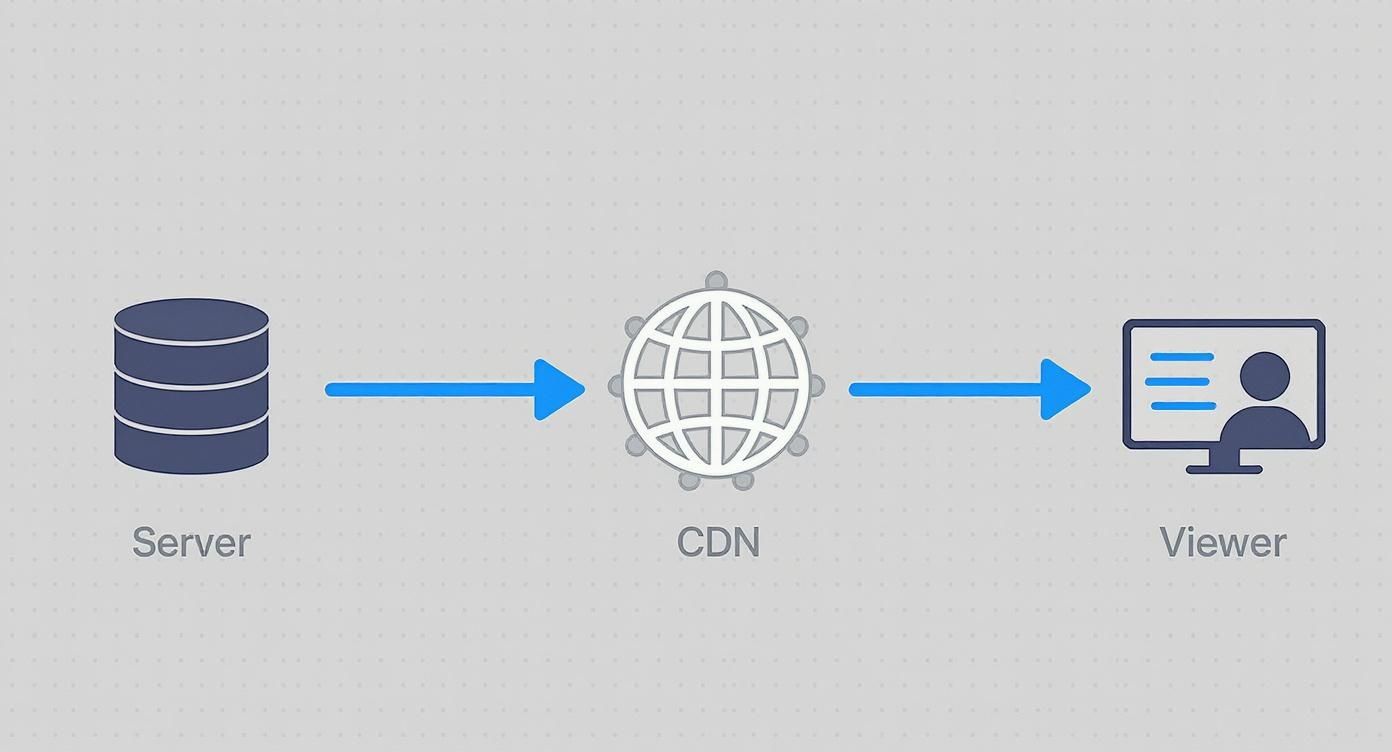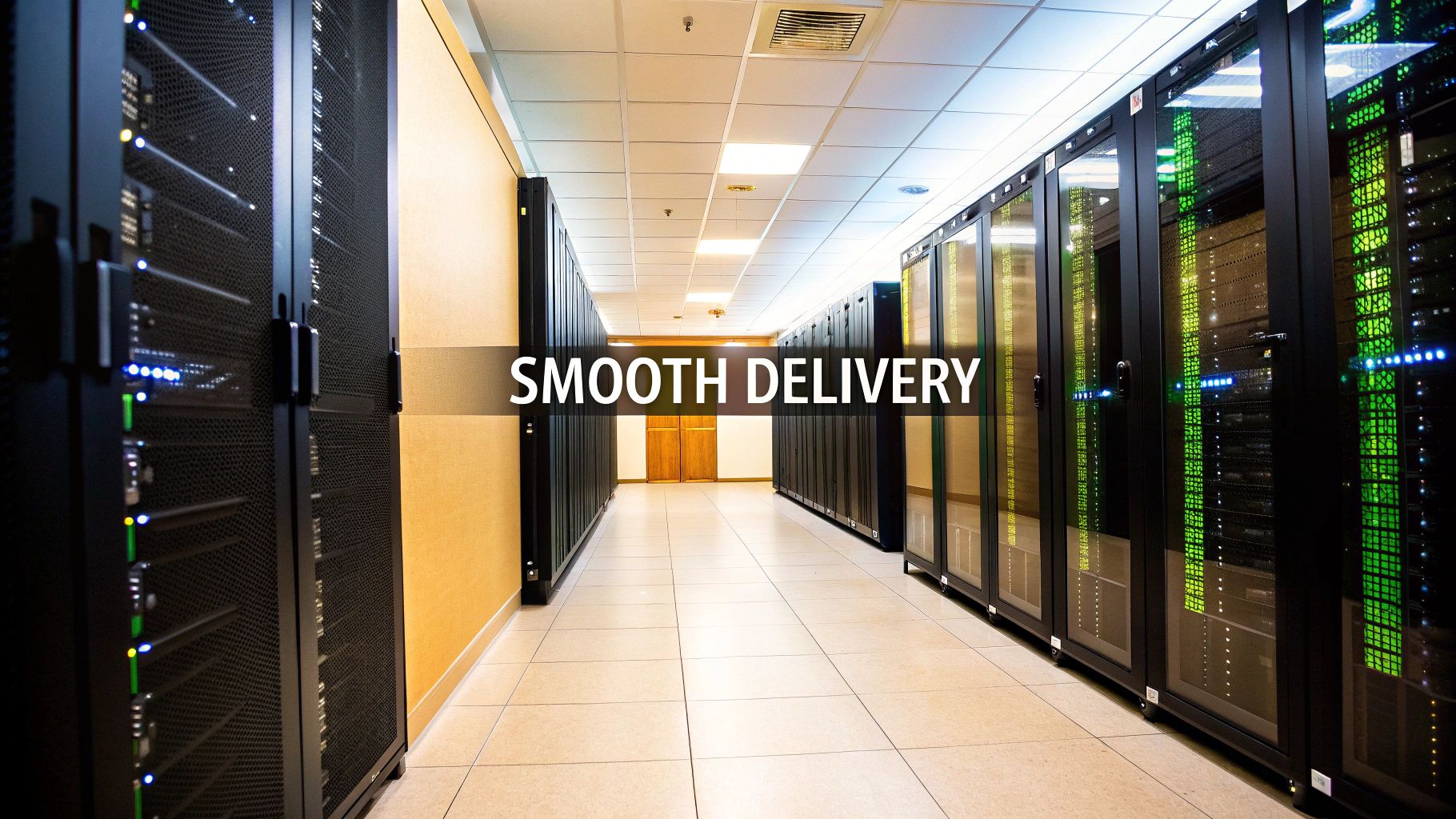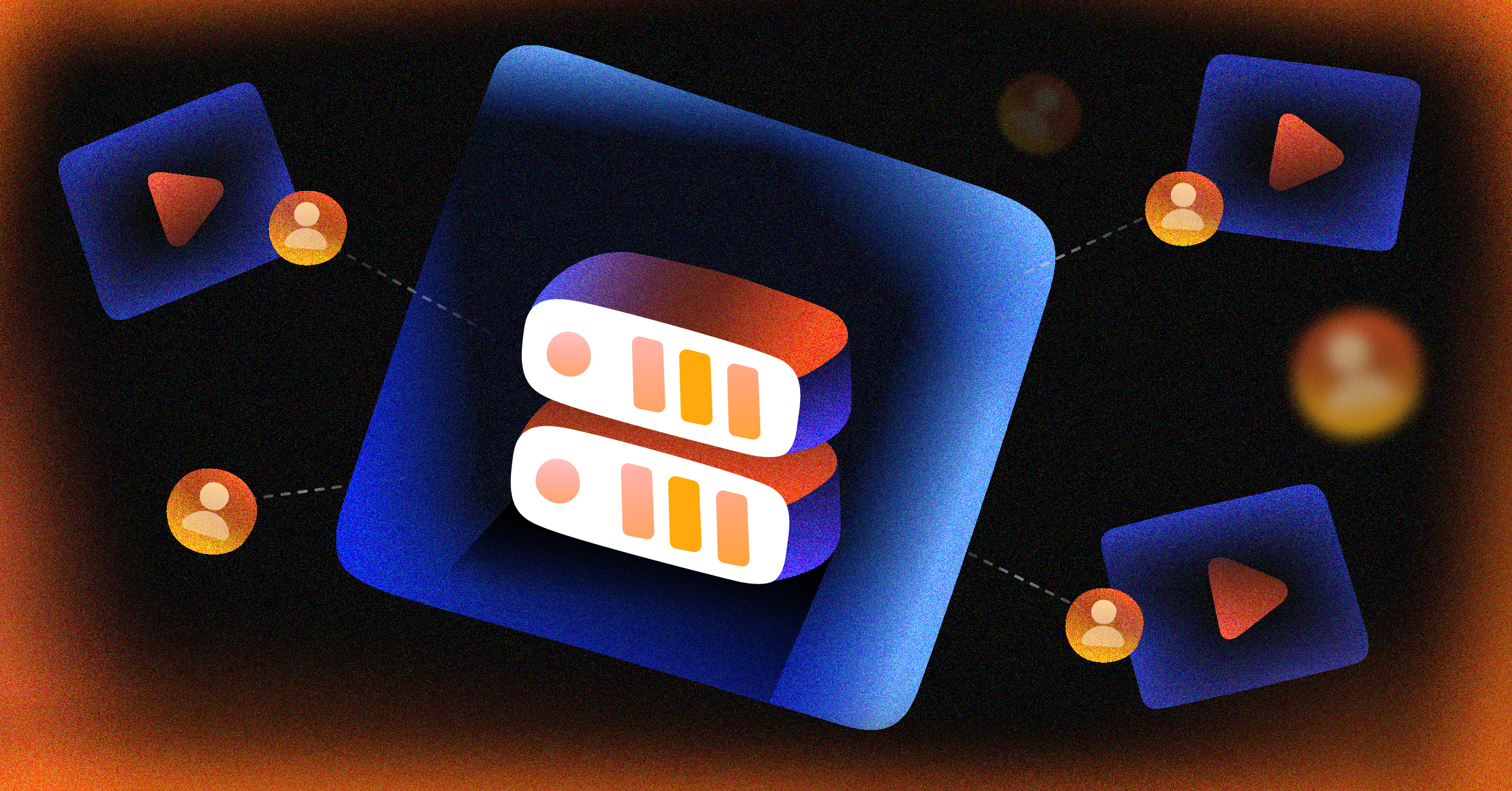A video streaming CDN is a purpose-built network of servers spread across the globe, all working together to deliver video content as quickly and reliably as possible. It’s all about closing the distance. The CDN stores copies of your videos in multiple locations, so when a viewer hits play, the stream comes from a server right around the corner from them, not from halfway across the world. This simple principle is what kills frustrating buffering and makes load times feel instant.
Your Guide to Fast and Reliable Video Delivery
Think about it like this: trying to stream video from a single server is like shipping a package from one warehouse in Texas to the entire world. A customer in Tokyo? They’re going to be waiting a long, long time. Data has to travel physical distances across undersea cables and networks, and that travel time translates directly into lag and a choppy viewing experience.
A video streaming CDN (Content Delivery Network) completely flips this model on its head. It’s less like a single central warehouse and more like a global chain of local distribution centers.
The CDN takes your video content and places copies of it in these “distribution centers,” which we call Points of Presence (PoPs) or edge servers. These are strategically placed in data centers all over the world. So, when that viewer in Tokyo requests your video, their request doesn’t travel all the way to Texas. Instead, it’s automatically sent to the nearest PoP in Asia, delivering the video almost instantly.
Why is This So Important?
Let’s be honest, attention spans are shorter than ever. Viewers expect flawless, high-definition playback the second they press play, no matter where they are. A stream that constantly buffers is the fastest way to lose someone’s interest. For any business or creator, that means lost engagement, tanking ad revenue, and a serious hit to your brand’s reputation.
So, what are the key pieces that make this all work? It boils down to a few core components:
- Origin Server: This is home base. It’s your main storage—the “central factory” where the original video files live.
- Edge Servers: These are the workhorses of the CDN. They’re the distributed servers that cache (or store temporary copies of) your videos, getting them much closer to your audience.
- Intelligent Routing: This is the brains of the operation. The CDN has a system that instantly figures out where a viewer is and routes their request to the best-performing edge server for them.
By slashing the physical distance data has to travel, a video streaming CDN fundamentally changes the delivery game. It turns a slow, cross-continental trek into a quick, local sprint. That’s the real secret behind every major streaming service you use.
This kind of infrastructure is the backbone of how we watch video today, powering everything from live-streamed global sports to your favorite on-demand movie platform. It provides massive scalability, so you can serve ten viewers or ten million without your main server breaking a sweat. In the end, using a specialized CDN isn’t just a nice-to-have; it’s a non-negotiable for delivering a professional-grade video experience that keeps people watching.
How a Video CDN Delivers Flawless Streams
To really get what a video streaming CDN does, let’s track a single video file on its journey from your server to a viewer’s screen. It’s not as simple as sending a file from point A to point B. Instead, it’s a beautifully choreographed dance of smart routing, caching, and on-the-fly adjustments that all happen in a split second.
Picture this: someone across the world clicks “play” on your video. Their request doesn’t have to make the long, slow trip all the way back to your main server (which we call the origin server). The CDN’s intelligent routing system kicks in immediately. Think of it like a hyper-efficient traffic controller for the internet, instantly figuring out where the viewer is and the fastest network path to get the video to them.
From there, the request is shot over to the nearest Point of Presence (PoP). A PoP is basically a data center packed with specialized servers, and a good CDN has hundreds, or even thousands, of them dotted all over the globe.
The Power of Caching and Proximity
This is where the real magic happens. The very first time a video is requested in a certain region, the local PoP’s server grabs it from your origin server and saves a temporary copy. This process is called caching. Now, when the next person in that same city or country wants to watch, the video is delivered directly from that local server.
By serving content from a local cache, a CDN dramatically reduces latency—the time it takes for data to travel. This is the fundamental principle that transforms a potentially long, laggy journey into a short, local hop, resulting in near-instant load times.
This entire flow is designed to bring content closer to the end-user, bypassing the bottleneck of a single origin server.

As you can see, decentralizing delivery is key. The CDN acts as the critical middleman, ensuring a fast and reliable stream no matter where your audience is.
Adapting on the Fly for Uninterrupted Playback
But what if the viewer’s internet connection is spotty? A top-tier video streaming CDN doesn’t just send a one-size-fits-all file. It uses a clever technology called Adaptive Bitrate Streaming (ABS) to ensure a smooth experience, no matter what.
Here’s how it works. Before delivery, your video is encoded into several different versions, each at a different quality and file size (think 480p, 720p, 1080p, 4K). When someone starts watching, the CDN’s player instantly detects their current bandwidth and what their device can handle.
The video is then delivered in small segments, or chunks, and the player constantly monitors the connection. This allows it to switch quality levels without you even noticing.
- Strong Connection: If the viewer has fast 5G or fiber internet, they get the high-bitrate, 4K version for the best possible picture.
- Weak Connection: If their signal suddenly drops—maybe they’re driving through a tunnel—the CDN instantly switches to a lower-bitrate version to avoid buffering.
- Connection Improves: Once their connection is stable again, it seamlessly shifts back up to a higher quality.
This constant, automatic adjustment is what prevents that dreaded buffering wheel—the one that causes 81% of viewers to give up on a stream. This system works hand-in-hand with protocols like HLS. If you want to dig deeper into the nuts and bolts, you can learn more about HTTP Live Streaming and see how it breaks video into those manageable chunks.
By combining smart routing, local caching, and adaptive bitrate technology, a video CDN builds a tough and incredibly efficient delivery pipeline. It’s a dynamic system designed to beat the internet’s natural limitations, making sure every viewer gets a flawless, broadcast-quality experience every time they press play.
Key Benefits of Using a Video Streaming CDN
Choosing a specialized network for your video delivery isn’t just a technical tweak—it’s a strategic decision that directly shapes your viewer’s experience, your ability to grow, and your content’s security. A video streaming CDN brings real, measurable advantages to the table for any modern content platform. These aren’t just abstract perks; they translate into more engaged viewers, less operational risk, and a far more professional final product.
The most immediate and obvious benefit is a massive jump in performance. In the world of video streaming, every millisecond matters, and latency—that frustrating delay between hitting play and the video starting—is your worst enemy. A CDN tackles this head-on by storing copies (or caches) of your video on servers scattered across the globe, dramatically cutting down the physical distance your data needs to travel.
This proximity means faster load times, almost zero buffering, and a silky-smooth playback experience that keeps viewers glued to their screens. Let’s be honest, lag is one of the top reasons people click away from a stream. Improving performance is the first and most critical step in building a dedicated audience.

Achieving Reliability at Any Scale
Picture this: your live event unexpectedly goes viral. Your audience count explodes from a few hundred to tens of thousands in a matter of minutes. Without a CDN, this dream scenario would instantly turn into a technical nightmare. Your single origin server would get swamped by requests, leading to agonizingly slow performance or, worse, a complete crash.
A video streaming CDN is built for exactly this kind of moment. It delivers incredible reliability and scalability by spreading the traffic load across its huge network of servers.
Instead of one server trying to handle every single request, thousands of edge servers share the work. This distributed setup ensures your stream stays stable and online, whether you have ten viewers or ten million. The CDN automatically scales to meet the demand without you having to lift a finger, guaranteeing a consistent, high-quality experience for everyone.
A CDN acts as an insurance policy against your own success. It allows you to grow your audience without the fear of your infrastructure failing under pressure, ensuring a stable and professional broadcast every time.
This kind of reliability is the backbone of the global video streaming market, which was valued at USD 129.26 billion in 2024. It’s projected to soar to USD 416.8 billion by 2030, largely fueled by the massive demand for high-quality video on mobile devices. This growth is only possible because of the powerful delivery networks that CDNs provide. You can discover further insights into video streaming trends and see just how big this market is becoming.
Fortifying Your Content with Robust Security
Beyond speed and scale, security is a huge concern for anyone creating content. Your videos are valuable assets, and protecting them from pirates or cyber threats is non-negotiable. A video streaming CDN serves as a powerful front line of defense, offering multiple security layers to protect both your content and your core infrastructure.
Most CDNs come with built-in protections against the most common types of cyberattacks. These features are critical for keeping your video services online and uncompromised.
Here are a few key security advantages a CDN brings to the fight:
- DDoS Mitigation: Distributed Denial of Service (DDoS) attacks are designed to flood your server with junk traffic, knocking your stream offline. A CDN can absorb and filter out this malicious traffic at the edge of its network, so it never even gets close to your origin server.
- Token Authentication: This clever feature stops people from stealing your content and embedding it on their own sites (a practice known as “hotlinking”). The CDN generates a unique, short-lived token for each viewer, making sure only authorized users can access your stream.
- Geoblocking and Access Control: CDNs give you the power to restrict who can see your content based on their geographic location. This is absolutely essential for enforcing licensing deals or regional content blackouts.
By handing off these heavy-duty security tasks to the CDN, you’re not just protecting your valuable content—you’re also freeing up your own team to focus on what they do best: creating amazing experiences for your audience. It’s this powerful combination of speed, scale, and security that makes a video CDN an essential tool for anyone serious about streaming.
Must-Have Features of a Modern Video CDN

When you start looking at a video streaming cdn, it’s easy to get buried in technical jargon. But here’s the thing: not all networks are created equal. The real difference between a basic service and a top-tier delivery powerhouse lies in a specific set of features built to handle the unique stress of video.
Think of it like buying a car. Sure, any car gets you from A to B. But a high-performance vehicle comes with a specialized suspension, a powerful engine, and better safety systems for a reason. In the same way, a modern video CDN does more than just cache content; it’s a full suite of tools designed for flawless delivery, tight security, and deep performance insights.
Getting a handle on these key features is the first step to making a smart choice. This isn’t just about ticking boxes; these capabilities have a direct impact on your stream’s quality, how well it scales, and whether it’s secure.
Comprehensive Format and Protocol Support
Your audience is everywhere, watching on smart TVs, iPhones, gaming consoles, and everything in between. A solid CDN has to be a universal translator, supporting the industry-standard protocols that make video work across this fragmented landscape. This is how you ensure your content just plays, no matter the screen.
The two non-negotiables you need to look for are:
- HLS (HTTP Live Streaming): Developed by Apple, HLS is the king of compatibility. It works on nearly every device and browser by breaking video into small chunks, which is the secret sauce behind adaptive bitrate streaming.
- DASH (Dynamic Adaptive Streaming over HTTP): As an open-source alternative, DASH is also incredibly popular and delivers excellent adaptive streaming, particularly on Android devices and modern browsers.
Beyond just the protocols, your CDN has to handle video that’s been properly prepared for delivery. A crucial part of that preparation is transcoding, the process of reformatting video files for broad compatibility. To really get a grip on this, check out our guide on what video transcoding is and why it’s so fundamental to streaming today.
Robust Security and Access Control
Your video content is a valuable asset. That means it needs protection from piracy, unauthorized access, and cyberattacks. A premium video streaming cdn is your first line of defense, building security right into the delivery pipeline. For anyone serious about protecting revenue and intellectual property, this is a must.
Key security features to look for include:
- Token Authentication: This stops hotlinking dead in its tracks by generating a secure, time-sensitive token for every stream. Only viewers with a valid token can watch, preventing people from embedding your player on their own sites without permission.
- DRM (Digital Rights Management): For premium content, DRM adds a powerful layer of encryption that makes it incredibly difficult for pirates to copy and illegally share your videos.
- Geoblocking: This feature gives you control over where your content can be viewed. It’s essential for enforcing licensing agreements or respecting regional broadcast blackouts.
Think of CDN security as a digital bouncer for your content. It checks every viewer’s credentials at the door, ensures they are in the right location, and protects the venue from outside threats, allowing you to focus on the show.
Advanced Analytics and Real-Time Monitoring
You can’t fix what you can’t see. A truly modern CDN gives you a detailed analytics dashboard, offering deep insights into both viewer behavior and network performance. This data is gold for optimizing your content strategy and sniffing out technical issues before they ruin someone’s viewing experience.
Your CDN should provide real-time data on:
- Viewer Engagement: Metrics like total plays, watch time, and completion rates tell you exactly what content is hitting the mark with your audience.
- Quality of Experience (QoE): Keep an eye on buffering ratios, video startup times, and quality levels to make sure the viewing experience is buttery smooth.
- Geographic Distribution: See where your viewers are tuning in from. This helps you make smarter decisions about content targeting and where to focus your resources.
This kind of insight turns a CDN from a simple delivery pipe into a strategic business tool. It’s this demand for intelligent, data-driven delivery that’s fueling massive growth in the market. The global CDN market was valued at USD 27.59 billion in 2024 and is projected to hit USD 144.91 billion by 2034, all because platforms need these advanced capabilities.
How to Choose and Implement Your Video CDN
Alright, so you understand what a video streaming CDN does. Now for the fun part: picking one and getting it to work for you. It might sound like a huge technical hurdle, but it really just boils down to matching a provider’s strengths to what you actually need to accomplish. Get this choice right, and you’re setting yourself up for a smooth, professional-grade streaming experience.
Putting this into action is a two-step dance. First comes the evaluation. You need to carefully vet potential CDN partners because they are not all created equal. A CDN built for a massive, global gaming company is going to be a different beast than one designed for a local news station. A little homework here will save you a world of headaches and money later.
Then comes the implementation. This is where you connect your video files to the CDN’s network so it can do its job. While that might sound intimidating, most modern CDNs have made this surprisingly simple. Often, it’s just a few configuration tweaks to get the ball rolling.
Key Factors in Selecting Your CDN
Choosing a provider is the single most important decision you’ll make in this process. It directly impacts your viewers’ experience, your budget, and how easily you can grow. To cut through the noise, focus on these essential criteria that separate the contenders from the pretenders.
Here are the four pillars of a smart selection process:
- Global Reach and Performance: Take a hard look at the provider’s network map. Do they have Points of Presence (PoPs) where your audience actually lives? The closer their servers are to your viewers, the lower the latency and the better the stream. It’s that simple.
- Pricing Model and Predictability: CDN pricing can be all over the place. Some providers use a pay-as-you-go model based on the bandwidth you use, while others offer flat-rate monthly plans. Think about your traffic. If your viewership spikes unexpectedly, a flexible plan is great. If it’s steady and predictable, a fixed plan might save you cash.
- Technical Support Quality: When your live stream stutters mid-event, you need an expert on the line—now. Dig into the quality and availability of their technical support. Is it 24/7 phone and chat, or are you stuck submitting an email ticket and hoping for the best? For mission-critical video, top-notch support is non-negotiable.
- Live vs. On-Demand Optimization: Many CDNs handle both, but some are specialists. If your world revolves around live events, you need a CDN obsessed with ultra-low latency protocols and instant scalability. For video-on-demand (VOD), things like smart caching rules and easy storage integration matter more.
This decision is more critical than ever. The global Live Video CDN market is expected to hit roughly $15 billion by 2025 and is projected to keep growing at 18% each year through 2033. That explosive growth shows just how crucial reliable live delivery has become.
Demystifying the Implementation Process
Once you’ve picked your CDN, it’s go-time. This isn’t as complicated as it sounds. Here’s a high-level look at the typical steps to get your video streaming CDN fired up.
- Configure Your Origin Storage: First, you have to tell the CDN where your original video files live. This “origin” is usually a cloud storage service like Amazon S3 or your own web server. You’ll just pop the origin’s address into your CDN provider’s control panel.
- Create a CDN Distribution: Next, you set up a “distribution” (or “property”). Think of it as a rulebook for how the CDN should cache and deliver your content. The CDN will then give you a new domain name for your videos, something like
yourcdn.provider.com. - Update Your Application: The final step is to swap out the video URLs in your website or app. Instead of pointing to your own server, they’ll now point to the new CDN domain. For instance, a URL like
yourwebsite.com/video.mp4becomesyourcdn.provider.com/video.mp4. That’s it. This one small change reroutes all your video traffic through the CDN’s global network.
By following these steps, you effectively place the CDN between your content and your audience, offloading all the heavy lifting of video delivery. This allows you to focus on creating great content, knowing the technical delivery is handled by experts.
Platforms like LiveAPI make this even easier by integrating with top-tier CDNs and handling the configuration behind the scenes. If you’re stuck trying to compare the options, our guide on the best CDN for video streaming breaks down the top players to help you choose with confidence.
The Future of Video Content Delivery
A video streaming CDN is already a non-negotiable part of modern digital media, but the technology is far from finished. If you think CDNs are just about speed today, the future is about to blow your mind. Viewer expectations for instant, interactive, and ultra-high-quality video are pushing CDNs to evolve from simple delivery pipes into smart, dynamic networks that anticipate our every click.
One of the coolest shifts on the horizon is the move toward peer-to-peer (P2P) CDNs. Think of it like this: instead of everyone pulling a video from a central server, this model turns viewers into mini-broadcasters. As you watch a stream, your device shares tiny bits of it with others watching nearby. This seriously cuts down the strain on the main servers and slashes bandwidth costs for the provider. For a massive live event like a global sports final, this approach creates a network that actually gets stronger and more reliable as more people join in.
Pushing Intelligence to the Edge
At the same time, edge computing is moving the brains of the operation right to your doorstep. A traditional CDN is great at storing a copy of a video close to you, but the edge can actually run applications and make decisions on those nearby servers.
This unlocks some incredible real-time experiences that were just a pipe dream before because of latency. Imagine watching a live concert and being able to switch between camera angles yourself, with no buffering. Or think about live shopping, where clicking on a product instantly triggers a personalized video demo. That’s the kind of zero-delay interactivity edge computing makes possible.
By processing data right at the edge, CDNs can build and deliver dynamic, personalized content on the fly. This isn’t just a content delivery network anymore; it’s becoming a content experience network, where interaction is baked right into the delivery itself.
The Rise of AI-Powered Optimization
Artificial intelligence is the secret sauce tying all of this together. AI algorithms are completely changing how a video streaming CDN thinks, moving it from a reactive system to a predictive one. Instead of just waiting for you to hit play, an AI can analyze viewing trends and guess which video is about to go viral in your city, caching it on a local server before you even ask for it.
AI is also a master traffic controller. It can monitor the internet for congestion in real time and intelligently reroute your video stream around the bottlenecks, always finding the clearest path. This is how a video CDN becomes more than just a utility—it becomes a core strategic tool for building the next generation of video experiences that are faster, more dependable, and way more engaging for everyone.
Frequently Asked Questions About Video CDNs
Even after getting the hang of how a video streaming CDN works, you’re probably left with a few practical questions. Let’s tackle some of the most common ones I hear, clearing up the distinctions, talking about real-world costs, and even touching on some more advanced strategies.
What Is the Difference Between a Regular and Video CDN?
Think of a standard CDN like a general-purpose delivery van. It’s great for hauling all sorts of packages—images, stylesheets, text files. A video CDN, on the other hand, is a highly specialized armored truck built for one specific, high-stakes job: delivering massive, time-sensitive video files without a hitch.
A video streaming CDN is specifically engineered for:
- Heavy Lifting: It’s built to cache and serve enormous video files that can run into multiple gigabytes.
- Modern Streaming Protocols: It understands the language of video, with built-in support for HLS and DASH. These are the backbones of live broadcasts and the adaptive bitrate streaming that keeps your video playing smoothly even on a weak connection.
- Speed is Everything: From the ground up, every part of the network is tuned to shave off milliseconds of delay, which is absolutely essential for live events where every second counts.
Sure, a regular CDN can deliver a video file. But it just doesn’t have the specialized guts to do it reliably at scale. You’ll quickly run into buffering and lag, which is a death sentence for viewer engagement.
How Much Does a Video CDN Typically Cost?
This is the “how long is a piece of string” question, but I can give you some general guideposts. CDN pricing is almost always a pay-as-you-go game. The main factors are how much data you push (measured in gigabytes or terabytes) and where in the world your viewers are. Delivering content to North America and Europe is usually cheaper than sending it to more remote or less connected regions in South America or Asia.
Most providers have pricing tiers, so the more you use, the less you pay per gigabyte. A small to medium-sized streaming service might see a monthly bill anywhere from a few hundred to a couple of thousand dollars. But for a major broadcaster, that number can climb much, much higher as your audience grows.
Can You Use More Than One CDN at the Same Time?
Absolutely. In the industry, we call this a multi-CDN strategy, and it’s standard practice for any serious, large-scale streaming operation. The idea is to use two or more CDN providers simultaneously. This lets you intelligently route your viewers to the CDN that’s performing best in their specific region at that exact moment.
This approach gives you a massive boost in reliability. If one CDN has an outage or a performance dip, traffic is automatically shifted to the other, keeping your stream online and your viewers happy.
A multi-CDN setup is your ultimate insurance policy. It eliminates single points of failure and squeezes out the best possible performance by playing to the strengths of different global networks. The end result is a better, more consistent experience for every single user.
How Does a CDN Improve Video SEO?
A CDN doesn’t have a direct line to search engine algorithms, but its impact on your video SEO is undeniable. It all comes down to user experience. Search engines like Google are obsessed with how users interact with your site, and a huge part of that is speed.
By using a video streaming CDN, you slash video start-up times to almost nothing and get rid of frustrating buffering. Viewers stick around longer and are less likely to bounce off your page. These are powerful signals to Google that your content is high-quality and engaging, which can give your search rankings a very real boost over time.
Ready to deliver flawless video without the infrastructure headaches? LiveAPI integrates with top-tier CDNs to provide a powerful, developer-friendly platform for all your streaming needs. Explore our flexible and scalable solutions at https://liveapi.com.









